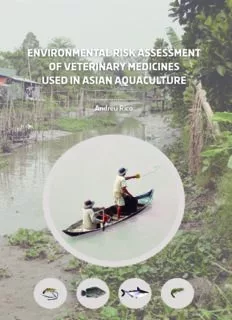
Environmental risk assessment of veterinary medicines used in Asian aquaculture PDF
Preview Environmental risk assessment of veterinary medicines used in Asian aquaculture
Andreu Rico Environmental risk assessment of veterinary medicines used in Asian aquaculture Andreu Rico 1 Thesis committee Thesis supervisor Prof. Dr. Ir. Paul J. van den Brink Professor of Chemical Stress Ecology Wageningen University Other members Prof. Dr. Johan A. J. Verreth, Wageningen University Prof. Dr. Jonas S. Gunnarsson, Stockholm University, Sweden Dr. Ir. Cornelis A. M. van Gestel, VU University Amsterdam, The Netherlands Dr. Ir. Jeroen B. Guinée, Leiden University, The Netherlands This research was conducted under the auspices of the Graduate School for Socio-Economic and Natural Sciences of the Environment (SENSE) 2 Environmental risk assessment of veterinary medicines used in Asian aquaculture Andreu Rico Thesis Submitted in fulfilment of the requirements for the degree of doctor at Wageningen University by the authority of the Rector Magnificus Prof. Dr. M. J. Kropff, in the presence of the Thesis Committee appointed by the Academic Board to be defended in public on Monday 26 May 2014 at 11.00 am in the Aula. 3 Andreu Rico Environmental risk assessment of veterinary medicines used in Asian aquaculture, 216 pages PhD Thesis, Wageningen University, Wageningen, NL (2014) With references, with summary in English, Dutch and Spanish ISBN 978-94-6173-956-8 4 To Neus and to my family 5 6 ‘’The chemicals to which life is asked to make its adjustments are no longer merely the calcium and silica and copper and all the rest of minerals washed out of the rocks and carried in rivers to the sea; they are the synthetic creations of man’s inventive mind, brewed in his laboratories, and having no counterparts in nature.’’ (Rachel Carson, 1962) 7 8 Contents Chapter 1. General introduction ...................................................................................................... 11 Chapter 2. Use of chemicals and biological products in Asian aquaculture and their potential environmental risks: a review ....................................................................... 19 Chapter 3. Use of veterinary medicines, feed additives and probiotics in four major internationally traded aquaculture species farmed in Asia ......................................... 37 Chapter 4. Modelling environmental and human health risks of veterinary medicinal products applied in pond aquaculture ........................................................................ 55 Chapter 5. Probabilistic risk assessment of veterinary medicines applied to four major aquaculture species produced in Asia .......................................................................... 71 Chapter 6. Use, fate and ecological risks of antibiotics applied in tilapia cage farming in Thailand ........................................................................................................................ 89 Chapter 7. Ecological risk assessment of the antibiotic enrofloxacin applied to Pangasius catfish farms in the Mekong delta, Vietnam .............................................................. 109 Chapter 8. Effects of the antibiotic enrofloxacin on the ecology of tropical eutrophic freshwater microcosms .............................................................................................. 125 Chapter 9. Predicting antibiotic resistance in aquaculture production systems and surrounding environments ......................................................................................... 145 Chapter 10. General discussion and conclusions........................................................................... 165 References. .................................................................................................................................... 179 Summary.... .................................................................................................................................... 195 Samenvatting (Dutch summary) .................................................................................................... 199 Resumen (Spanish summary) ........................................................................................................ 203 Acknowledgements ....................................................................................................................... 207 About the author ........................................................................................................................... 211 9
Description: